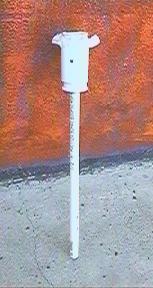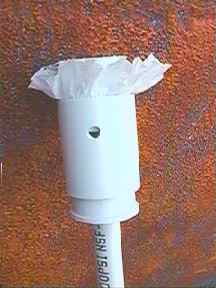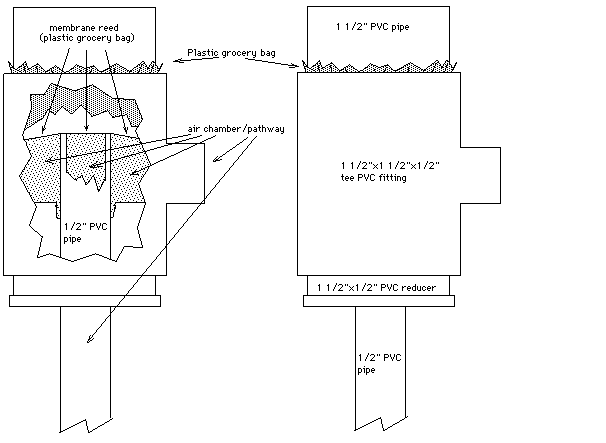 |
These are the first photos of this instrument. Several changes have
been made since then. The final prototype has a much shorter length of
1/2" pipe (it was trimmed when I tuned the instrument up to C).
|
 |
These are the first photos of this instrument. Several changes have
been made since then. The final prototype has a much shorter length of
1/2" pipe (it was trimmed when I tuned the instrument up to C).
|
|
|
 |
Inspired by a cheerleader's noisemaker, this can be quite a loud instrument. In his book, Musical Instrument Design, Bart Hopkin calls this sound generating system a membrane reed. Here, a membrane, made from a plastic grocery bag, is stretched across the end of an air column. As air exits the instrument, it is forced between the membrane and the end of the air column, causing the membrane to vibrate at an audible frequency. The resulting tone of this instrument is quite like a clarinet. A very loud clarinet.
Huh? Maybe this diagram can help.

A well stocked plumbing supply store is essential to construct this instrument. All parts fit snugly. Nothing is glued. The most difficult part of construction is removing the inside ridge on the 1 1/2" x 1/2" reducer (removing the ridge allows the 1/2" PVC pipe to pass through the reducer and into the air chamber). I used a Roto-Zip tool to do this (just an overgrown Dremel). A lathe can make a much cleaner cut.
The end of 1/2" pipe that butts against the membrane should be cut at a right angle and free from burrs or sharp edges. This allows the membrane to vibrate in a more reliable fashion and helps keep the thin plastic membrane from tearing. I used a pipe cutter to cut a smooth right angle, filed off the sharp edge and quickly wiped the end with acetone to smooth out any rough spots.
Tuning, as with any home-brew instrument, is totally up to you. My prototype is tuned to C and has a range of an octave plus one note. The amount of tension between the air column and the membrane has a great effect on the tuning of the instrument. The toneholes were placed to fit my fingers comfortably and enlarged to proper tone. If you wish to use a mathematical formula to place the toneholes (such as Peter Hoekje's spreadsheet), have at it. I've never really used a formula myself, since all those big scary equations make me want to watch TV.
Possible experiments? Try a different material for the membrane. I've used two types of grocery bag plastic. One was heavier that the other and produced a slightly different tone quality, but both worked fine. I also tried some sheet mylar (.003" thick), but it was too heavy and stiff to be useful on this design.
You can also try putting a 1 1/2" cap over the 1 1/2" PVC pipe end of the reed assembly. This acts as a mute and brings the volume down to a more reasonable level. It also changes the intonation a bit. It may also change the tone quality of the reed by creating another closed air chamber, adding some damping.
Finally, I added a 15" vinyl hose to the reed assembly as a mouthpiece, allowing me to place the instrument further away from my ear.
Back to FolkUrban Music
email me!:tpe123@yahoo.com